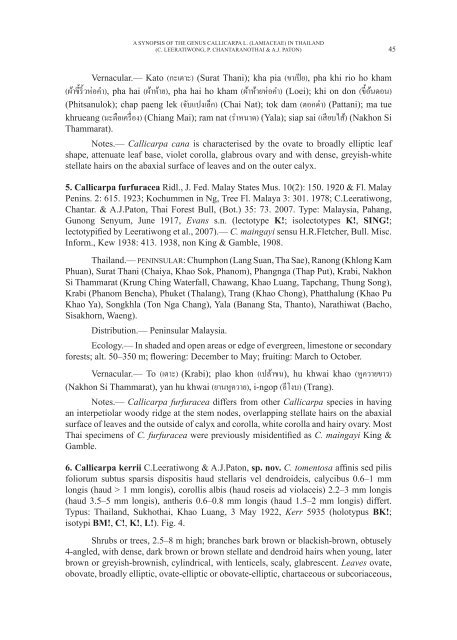You also want an ePaper? Increase the reach of your titles
YUMPU automatically turns print PDFs into web optimized ePapers that Google loves.
A SynOPSIS OF THE GEnUS CALLICARPA L. (LAMIACEAE) In <strong>THAI</strong>LAnD<br />
(C. LEERATIWOnG, P. CHAnTARAnO<strong>THAI</strong> & A.J. PATOn)<br />
Vernacular.— Kato (กะเตาะ) (Surat Thani); kha pia (ขาเปี ย), pha khi rio ho kham<br />
(ผ้าขี ้ริ้วห่อคำ), pha hai (ผ้าห้าย), pha hai ho kham (ผ้าห้ายห่อคำ) (Loei); khi on don (ขี ้อ้นดอน)<br />
(Phitsanulok); chap paeng lek (จับแปงเล็ก) (Chai nat); tok dam (ตอกดำ) (Pattani); ma tue<br />
khrueang (มะตือเครื่อง)<br />
(Chiang Mai); ram nat (รำหนาด) (yala); siap sai (เสียบไส้) (nakhon Si<br />
Thammarat).<br />
notes.— Callicarpa cana is characterised by the ovate to broadly elliptic leaf<br />
shape, attenuate leaf base, violet corolla, glabrous ovary and with dense, greyish-white<br />
stellate hairs on the abaxial surface of leaves and on the outer calyx.<br />
5. Callicarpa furfuracea Ridl., J. Fed. Malay States Mus. 10(2): 150. 1920 & Fl. Malay<br />
Penins. 2: 615. 1923; Kochummen in ng, Tree Fl. Malaya 3: 301. 1978; C.Leeratiwong,<br />
Chantar. & A.J.Paton, Thai Forest Bull, (Bot.) 35: 73. 2007. Type: Malaysia, Pahang,<br />
Gunong Senyum, June 1917, Evans s.n. (lectotype K!; isolectotypes K!, SING!;<br />
lectotypified by Leeratiwong et al., 2007).— C. maingayi sensu H.R.Fletcher, Bull. Misc.<br />
Inform., Kew 1938: 413. 1938, non King & Gamble, 1908.<br />
Thailand.— PEnInSULAR: Chumphon (Lang Suan, Tha Sae), Ranong (Khlong Kam<br />
Phuan), Surat Thani (Chaiya, Khao Sok, Phanom), Phangnga (Thap Put), Krabi, nakhon<br />
Si Thammarat (Krung Ching Waterfall, Chawang, Khao Luang, Tapchang, Thung Song),<br />
Krabi (Phanom Bencha), Phuket (Thalang), Trang (Khao Chong), Phatthalung (Khao Pu<br />
Khao ya), Songkhla (Ton nga Chang), yala (Banang Sta, Thanto), narathiwat (Bacho,<br />
Sisakhorn, Waeng).<br />
Distribution.— Peninsular Malaysia.<br />
Ecology.— In shaded and open areas or edge of evergreen, limestone or secondary<br />
forests; alt. 50–350 m; flowering: December to May; fruiting: March to October.<br />
Vernacular.— To (เตาะ) (Krabi); plao khon (เปล้าขน), hu khwai khao (หูควายขาว)<br />
(nakhon Si Thammarat), yan hu khwai (ยานหูควาย), i-ngop (อีโงบ) (Trang).<br />
notes.— Callicarpa furfuracea differs from other Callicarpa species in having<br />
an interpetiolar woody ridge at the stem nodes, overlapping stellate hairs on the abaxial<br />
surface of leaves and the outside of calyx and corolla, white corolla and hairy ovary. Most<br />
Thai specimens of C. furfuracea were previously misidentified as C. maingayi King &<br />
Gamble.<br />
6. Callicarpa kerrii C.Leeratiwong & A.J.Paton, sp. nov. C. tomentosa affinis sed pilis<br />
foliorum subtus sparsis dispositis haud stellaris vel dendroideis, calycibus 0.6–1 mm<br />
longis (haud > 1 mm longis), corollis albis (haud roseis ad violaceis) 2.2–3 mm longis<br />
(haud 3.5–5 mm longis), antheris 0.6–0.8 mm longis (haud 1.5–2 mm longis) differt.<br />
Typus: Thailand, Sukhothai, Khao Luang, 3 May 1922, Kerr 5935 (holotypus BK!;<br />
isotypi BM!, C!, K!, L!). Fig. 4.<br />
Shrubs or trees, 2.5–8 m high; branches bark brown or blackish-brown, obtusely<br />
4-angled, with dense, dark brown or brown stellate and dendroid hairs when young, later<br />
brown or greyish-brownish, cylindrical, with lenticels, scaly, glabrescent. Leaves ovate,<br />
obovate, broadly elliptic, ovate-elliptic or obovate-elliptic, chartaceous or subcoriaceous,<br />
45
















